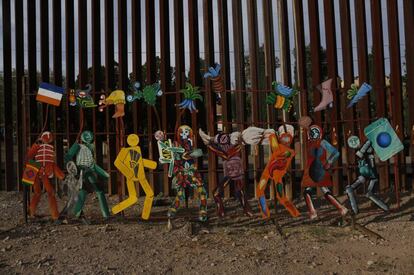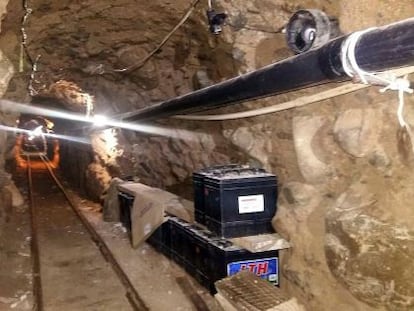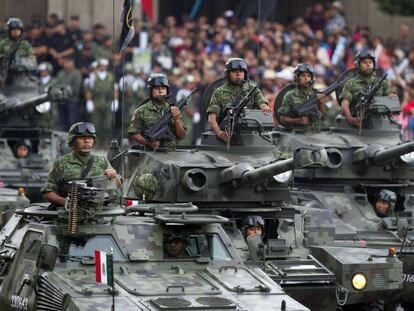By tunnel or by mule: how drugs are moved from Mexico into Arizona
The Sinaloa Cartel controls 90% of the narcotics shipped through this stretch of the US border

Sandra lives less than 10 minutes from Arizona but she cannot cross over to the US side because she does not have a visa. Her modest house with its unpainted walls sits atop a hill at the end of bumpy dirt road in Nogales, Sonora, a state in northern Mexico that is home to 234,000 people. The border wall that separates this Nogales from Nogales, Arizona – a town of some 20,000 people and a few stores where Mexicans with visas like to shop – runs next to her house. From the door of her home, Sandra can see the high fence, made of three-meter-high rusting metal pales, that divides the two countries and snakes across the hills toward the horizon.
“They found a drug tunnel in the pink house down there. Helicopters arrived that day and closed down the streets,” says the 38-year-old who lives in Buenos Aires, a shanty town outside Nogales whose strategic location means US officials regularly search there for tunnels. The gangs that control the underground routes patrol the area and there are informants with binoculars and radios on every avenue, street corner and alley, watching and reporting the movements of agents near the entrances to the tunnels, where drugs and people are trafficked into the United States.
The cartels are continually finding new ways to smuggle drugs
“Sometimes, when I’ve been outside washing clothes, I hear how they shout at them in their language to get down from the wall. When I see someone trying to climb over with a bag [of drugs] I go inside my house to avoid problems,” she says.
Sandra has lived in this slum for 15 years. Before the United States built its wall of rusted metal bars, she says, there was a shorter fence that locals would cut with pliers and slip through to go shopping “on the other side.” Then the fence was replaced with metal sheeting, until in 2007 the current barrier was put up.
“In the 1990s, I used to cross through the hole, as we used to say. There wasn’t all this technology,” Sandra says, pointing at security cameras on the other side.
A few meters down the road, a kindergarten decorated in bright colors stands in sharp contrast to the wall. Vanessa Quijada, the director of the school, says it is normal for young kids to see police activity and men scuttling over the wall. “They know the wall divides us, that it separates one country from the other,” she says. The street where the school is located runs all the way through downtown Nogales where men with backpacks filled with drugs climb up the rectangular bars in front of the stores just a few steps away from the checkpoint. “It’s a very common thing,” one shopkeeper explains. “They climb up like Spider-Man and quickly jump over to the other side.”
The Sinaloa Cartel has strengthened its presence in Arizona
According to municipal authorities, 40% of the population in Nogales, Sonora, is transient. Hundreds of people who have been deported from the United States stay in the town, sometimes indefinitely, most of them picking up jobs in manufacturing, waiting for another opportunity to enter the United States. Nogales was one of the first cities in northern Mexico to attract maquiladoras, or US assembly plants. Father Ricardo Reciado, who is involved in outreach work in troubled communities, says hundreds of young men and women have joined the drug trade as recruits. “They use primary and secondary school students to move drugs, as well as little boys from the slums to serve as informants,” he adds.
A dangerous border
The Arizona-Sonora border is one of the biggest entry points for drugs into the United States, and the Tucson border patrol is one of the busiest units, with eight stations covering most of Arizona, from New Mexico to Yuma County. Its agents typically seize around half of the marijuana that enters the country along the 350-kilometer border, says Vicente Paco, the spokesman for the Tucson border patrol.
The gangs operating here not only oversee the drugs trade, but also control the gun and migration routes, Paco says. “Any person who wants to enter the United States illegally has to join organized crime. They have to pay the organizations and if they don’t have money they are used as mules.”
One of the most dangerous areas along the Arizona-Sonora border is the Great Desert of Altar, a UNESCO World Heritage Site, where temperatures can reach 50ºC. Its inhospitableness makes it attractive to the drug traffickers, says the border patrol. A common way to transport drugs is to send the mules in groups of up to 15 to make the 15-day journey through the desert with 20 to 25 kilograms of marijuana strapped to their backs.
The gangs that control the tunnels use look-outs to spot border patrols
The organized crime network is so large it uses people on both sides of the border. Since 2014, more than 80 individuals have been arrested in the hills for spying on law-enforcement agents working at the border. “Before, a lookout who watched our police efforts would enter the country as an illegal immigrant and the only thing we could do was return him to his country,” one agent says. Now, if border patrol finds a campsite on a hill with paramilitary equipment and radios operating on secret frequencies, the state of Arizona will charge the suspect. “They are the eyes of the criminal organizations,” he adds.
A recent US border patrol report said agents seized 1.5 million pounds of marijuana and 4,294 pounds of cocaine in 2015, with Tucson alone accounting for 48.6% of all seizures. Agent Paco says he has seen a rise in the confiscation of methamphetamine, heroin and cocaine.
The cartels are continually diversifying the ways they transport drugs. Authorities have discovered 107 cross-border tunnels in Nogales alone, while each day dozens of men carrying drug shipments climb over the wall. “Nogales is also known as the tunnel capital. Since Sonora is a mining state there is the kind of technology [needed] to build this type of infrastructure,” Paco says. The border patrol has also found catapults, staircases and loading ramps near the border.
Meanwhile, the Sinaloa Cartel has reinforced its presence in Arizona in order to ramp up its shipments of marijuana and heroin, the Drug Enforcement Administration (DEA) says. The organization once led by imprisoned drug boss Joaquín El Chapo Guzmán, who is now fighting extradition to the United States, poses the greatest threat to Arizona’s communities, controlling an estimated 90% of drugs that cross the border. The Sinaloa cartel also controls arms and money-laundering routes.
English version by Dyane Jean-François.
Tu suscripción se está usando en otro dispositivo
¿Quieres añadir otro usuario a tu suscripción?
Si continúas leyendo en este dispositivo, no se podrá leer en el otro.
FlechaTu suscripción se está usando en otro dispositivo y solo puedes acceder a EL PAÍS desde un dispositivo a la vez.
Si quieres compartir tu cuenta, cambia tu suscripción a la modalidad Premium, así podrás añadir otro usuario. Cada uno accederá con su propia cuenta de email, lo que os permitirá personalizar vuestra experiencia en EL PAÍS.
¿Tienes una suscripción de empresa? Accede aquí para contratar más cuentas.
En el caso de no saber quién está usando tu cuenta, te recomendamos cambiar tu contraseña aquí.
Si decides continuar compartiendo tu cuenta, este mensaje se mostrará en tu dispositivo y en el de la otra persona que está usando tu cuenta de forma indefinida, afectando a tu experiencia de lectura. Puedes consultar aquí los términos y condiciones de la suscripción digital.
More information
Archived In
Últimas noticias
Most viewed
- Reinhard Genzel, Nobel laureate in physics: ‘One-minute videos will never give you the truth’
- Oona Chaplin: ‘I told James Cameron that I was living in a treehouse and starting a permaculture project with a friend’
- Pablo Escobar’s hippos: A serious environmental problem, 40 years on
- Chevy Chase, the beloved comedian who was a monster off camera: ‘Not everyone hated him, just the people who’ve worked with him’
- Why we lost the habit of sleeping in two segments and how that changed our sense of time










































